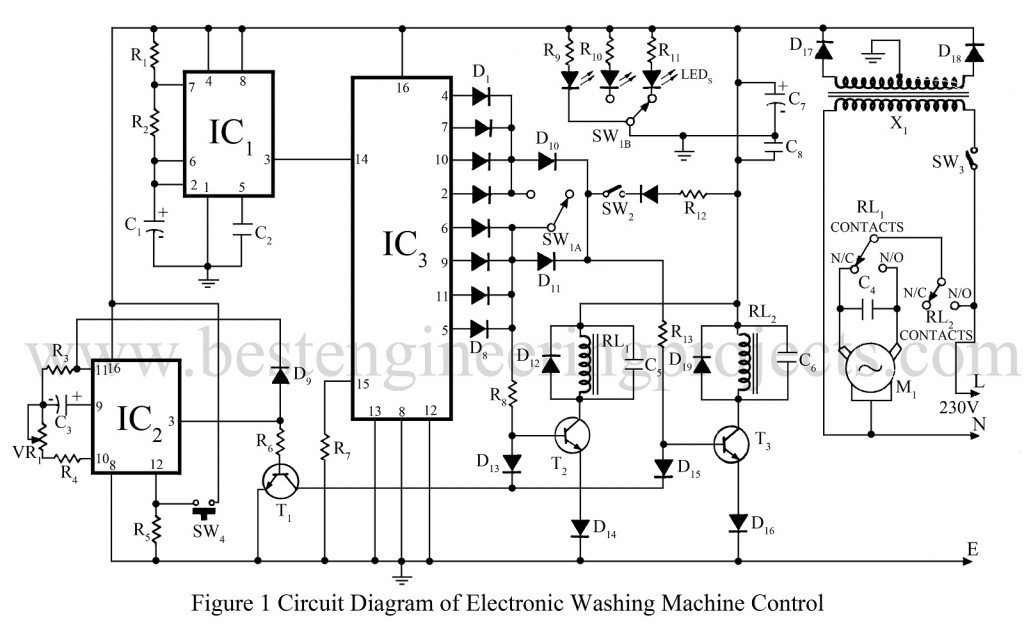Nowadays, commercially available washing machines are provided with features like the auto-off timer, reversible impeller, etc. Most of them have mechanical timers, reverses, etc. Some are equipped with electronic timers. But they are very expensive and out of reach of the average consumer.
Electronic Washing Machine Control circuit provides all the facilities provided by reputed companies and even more. The circuit has a timer circuit that can be set to any duration from 0 to 15 minutes and can be extended to any length of time by merely changing a capacitor. The circuit has switching circuits that run the impeller in one direction for 25 seconds and stop the motor for five seconds. This cycle repeats until the time set in the timer has elapsed.
An optional switch is provided to select normal/strong washes. During ‘normal’ washing, the impeller rotates in both directions alternatively with the five-second gap between reversals. This type of wash is suitable for delicate clothes. During ‘strong’ washing, the impeller rotates in one direction only with a five-second push after every 25 seconds.
Another switch is provided to select the ‘continuous’ facilities. In this mode, the impeller rotates in one direction only continuously. This mode is suitable for blankets, rugs, etc. You can also check another washing machine motor control circuit.
Circuit Description of Electronics Washing Machine Control

The heart of the circuit is IC3 which is a CMOS decade counter cum decoder. The IC provides ten outputs that go high one at a time for every clock pulse applied at pin 14. The clock pulses are obtained by IC1 NE555 wired in astable multivibrator mode. The second, third, fourth, and fifth outputs are OR’ed by four 1N4148 diodes (D1 – D4). Similarly, the 7th, 8th, 9th, and 10th outputs are OR, ed by another four 1N4148 diodes (D5 – D8). The first and sixth outputs are left unused.
When IC3 starts counting, the first pulse is not received by any diode, and during that period transistors T3 and T2 are off and the relays are also off, disabling the motor. During counts from the second to the fifth pulse, T3 is on and T2 is off. The motor runs in one direction for four clock pulses. During the sixth pulse, once again T3 and T2 are off and the motor stops. During seventh to tenth pulses, T3 and T2 are on and the motor runs in the opposite directions due to the switching of winding by relay RL1 contacts.
The timer is based on IC2 CD4060 which divides by 16384 counters. The timer can be set by a 1M potentiometer. After the set-time T1 switches T2 and T3 off, thus disabling the motor. The 4060 can be reset by the push-to-on switch provided.
Capacitor C4 is a starting capacitor already fixed to the motor. Relay RL1 and RL2 are 6V, 100 Ω, and 6A rated relays.
The circuit can be assembled on the general-purpose PCB. Mains wiring should be made with high current stranded copper wire. The circuit being fairly simple does not pose any problem.
Note: SW1 = Normal/Strong Selector
SW2 = Continuous Selector
SW4 = Reset
PARTS LIST of Electronic Washing Machine Control
|
Resistors (all ¼-watt, ± 5% Carbon) |
|
R1, R6 = 1 KΩ R2, R4 = 100 KΩ R3 = 1 MΩ R5 = 4.7 KΩ R7 = 10 KΩ R8, R12, R13 = 470 Ω R9-R11 = 750 Ω VR1 = 1 MΩ Lin. |
|
Capacitors |
|
C1 = 47 µF, 25V (Electrolytic Capacitor) C2, C5, C6 = 0.01 µF (Ceramic Disc) C3 = 1 µF, 25V (Electrolytic Capacitor) C4 = starting capacitor already connected with motor C6 = 1000 µF, 25V (Electrolytic Capacitor) C8 = 0.1 µF (Ceramic Disc) |
|
Semiconductors |
|
IC1 = NE555 (Timer IC) IC2 = CD4060 (14-stage Binary Ripple Counter IC) IC3 = CD4017 (Decade Counter IC) T1 – T3 = BC148B (General Purpose NON Transistor) D1 – D11, D13, D15 = 1N4148 (Signal Switching Signal Diode) D12, D14, D16 – D19 = 1N4001 (Rectifier Diode) |
|
Miscellaneous |
|
X1 = 220V C primary to 9V-0-9V 500mA secondary transformer M = 230V AC, ¼ HP reversible induction motor RL1, RL2 = 6V, 100Ω Relay SW1 = DPDT switch SW2 = SPST witch SW3 = ON/OFF switch SW4 = Push-To-On switch |
I want to learn more about the other cricket diagrams and theirs explain briefly.
Hello, I wanted the specifications of the blue colored ceramic capacitor of the Behi washing board model 618c
Thankful